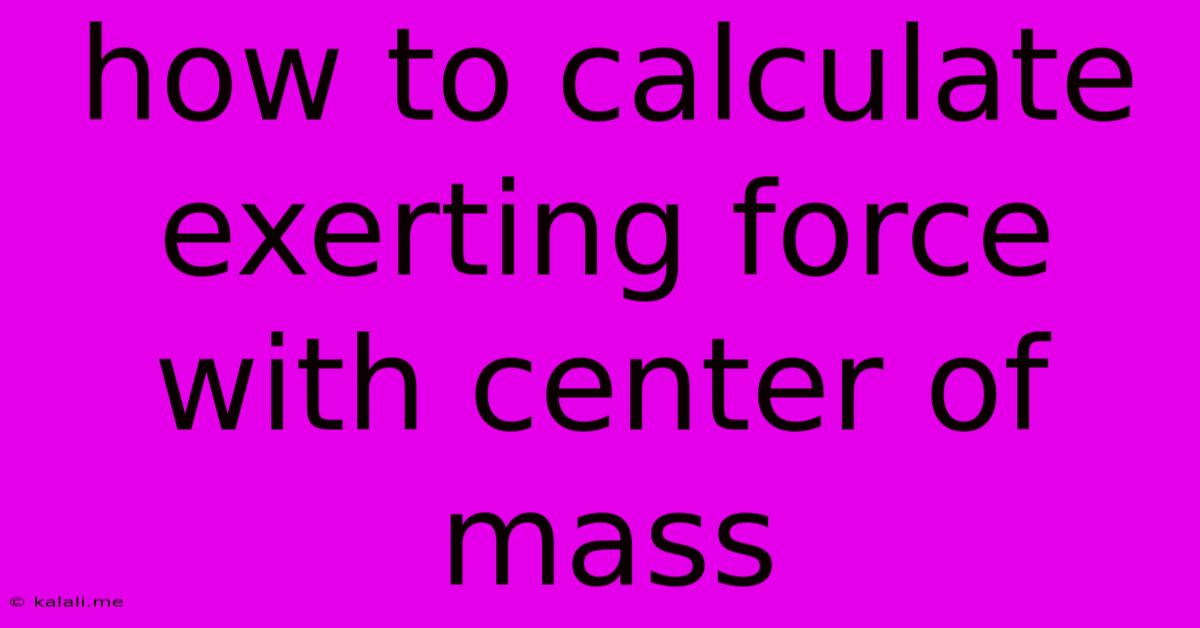How To Calculate Exerting Force With Center Of Mass
Kalali
Jun 05, 2025 · 4 min read

Table of Contents
How to Calculate Exerting Force with Center of Mass
Understanding how to calculate the force exerted by an object, considering its center of mass, is crucial in various fields, from physics and engineering to robotics and biomechanics. This article will delve into the principles and methods involved, providing a clear and concise guide for calculating this important parameter. We'll explore the relationship between center of mass, force, and equilibrium, equipping you with the knowledge to tackle diverse real-world problems.
Calculating the force exerted by an object, considering its center of mass, requires understanding several key concepts. First, we need to define the center of mass itself. The center of mass (COM) is the point where the entire mass of an object can be considered to be concentrated. For a simple, uniform object, the COM is at its geometric center. However, for irregular shapes or objects with uneven mass distribution, the COM's location requires calculation, often using calculus or numerical methods.
Understanding Center of Mass and its Importance
The center of mass is pivotal in force calculations because it simplifies the analysis of complex systems. Instead of considering the individual forces acting on every particle within an object, we can treat the object as a single point mass located at its center of mass. This simplification is incredibly useful in situations involving:
- Rotational motion: The COM is the point around which an object rotates. Knowing its location is essential for calculating torques and angular momentum.
- Equilibrium: An object is in equilibrium when the net force and net torque acting on it are zero. The COM plays a vital role in determining the conditions for both translational and rotational equilibrium.
- Impact analysis: Understanding the location of the COM is crucial for accurately modeling the effects of impacts and collisions.
Calculating Force Exerted by an Object Using its Center of Mass
The actual calculation of the exerted force depends heavily on the specific context. However, a common scenario involves an object resting on a surface or suspended by a support. In these cases, the force exerted by the object is equal and opposite to the supporting force (Newton's Third Law).
1. Objects at Rest:
When an object is at rest on a horizontal surface, the force exerted by the object on the surface is equal to its weight. The weight acts downwards through the center of mass. Therefore:
- Force exerted = mass × acceleration due to gravity (F = mg)
Where:
- F = Force exerted (Newtons)
- m = Mass of the object (kilograms)
- g = Acceleration due to gravity (approximately 9.81 m/s²)
2. Objects on Inclined Planes:
When an object rests on an inclined plane, the force exerted by the object is resolved into two components: a normal force perpendicular to the plane and a frictional force parallel to the plane. The normal force is still related to the weight of the object, but it's reduced by the component of the weight acting parallel to the plane. Calculating these components requires trigonometry, using the angle of inclination. The calculation involves resolving the weight vector into components parallel and perpendicular to the inclined surface.
3. Objects in More Complex Scenarios:
For more complex scenarios, such as objects with multiple support points or undergoing dynamic motion, more advanced techniques such as free body diagrams, and vector analysis are required. These techniques involve resolving forces into their components, applying Newton's laws of motion, and considering torques. Software simulation tools can also be beneficial for analyzing intricate systems.
Examples and Applications
The principles discussed above find application in a wide range of fields:
- Structural engineering: Determining the load-bearing capacity of structures requires accurate calculation of forces exerted by different components, considering their center of mass.
- Robotics: Understanding center of mass is crucial for designing stable and maneuverable robots.
- Biomechanics: Analyzing human movement, such as gait analysis, involves determining the forces exerted by different body segments, using their center of mass.
In conclusion, understanding the relationship between the center of mass and the force exerted by an object is essential for solving a variety of physics problems. While the basic principles are relatively straightforward, mastering the techniques requires a strong grasp of Newtonian mechanics and, in more complex situations, advanced mathematical tools. By carefully considering the object's mass distribution, geometry, and the external forces acting on it, you can accurately determine the exerted force, leading to more precise engineering designs and a deeper understanding of physical phenomena.
Latest Posts
Latest Posts
-
100 Amp Breaker Box Wiring Diagram
Jun 07, 2025
-
How Fast Can A Cop Car Go
Jun 07, 2025
-
Can Vulcans Mate With Humans For Pon Farr
Jun 07, 2025
-
How To Become Associate Editor Of A Journal
Jun 07, 2025
-
Can Elastic Potential Energy Be Negative
Jun 07, 2025
Related Post
Thank you for visiting our website which covers about How To Calculate Exerting Force With Center Of Mass . We hope the information provided has been useful to you. Feel free to contact us if you have any questions or need further assistance. See you next time and don't miss to bookmark.